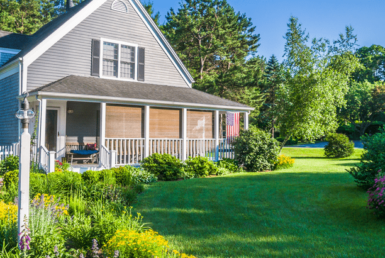Suffolk County Sellers Hold Out for More

A home with the right asking price, standout curb appeal, and a spotless interior has all the elements to attract high-quality offers from serious buyers. Sometimes, the offers roll in one after the next, which is especially true in our record-breaking Suffolk County real estate market. However, knowing when to accept an offer—and when to hold out for more—takes a little bit of insight, strategy, and timing.
The cardinal “first offer” rule
Conventional real estate wisdom says the first offer is the best offer. First offers come from qualified buyers who are invested in the process, pre-approved for a mortgage, and actively engaged with a mortgage lender or broker.
Expect serious buyers who have already narrowed down their search parameters, spent months learning the local market, and checked home prices for comparable properties in the area. Anticipate super excited buyers who possess dreams of moving in and the drive to beat out other buyers with well-thought-out offers.
Selling in our not-so-normal market
In a normal market, you roll the dice every time you reject an offer. Your house can linger on the market, signaling buyers there is something wrong with the property or price. It’s a vicious cycle that gets sellers into trouble. However, the current Suffolk County real estate market is anything but normal.
Despite a recent plateau in real estate prices, the average Suffolk County home still hovers around all-time highs. Last month, the median price climbed back up to $530,000, which was the record-high originally set back in August of 2021. Prices remain high due to low inventory—the number of homes sold dropped 18 percent across Long Island from March 2021 to March 2022, reflecting the shortage of listings.
The bottom line: homes are a hot commodity and sellers are holding out for more. Many sellers are waiting for better offers despite the good ones already on the table.
Risk, timing, and the cooling market
Even in a seller’s market, holding out for more comes with risk. Buyers in a hot market know to submit their highest and best offers from the start, which means that first offer might meet your objectives and priorities. Holding out for more also wastes time, which is an invaluable asset in a cooling housing market.
Experts forecast home prices will rise 11.2% over the next 12 months, which is a drop from the 19.2% price growth over the past 12 months. Home price growth could slow to 4.2% in 2023, giving sellers a reason to pull the trigger sooner rather than later and strike while the iron is hot.
There’s no rush to sell in a high-demand market—but waiting too long could impact your bottom line. Knowing when to pull the trigger means selling your home at the right price before prices go down. Sellers are already feeling the impact of a cooling housing market as 10 to 12 offers per home drops to 4 to 6.
Making your next move
After you list your home for sale, you grow increasingly eager, nervous, and anxious waiting to see who bites. Those negative emotions switch to euphoria when a buyer submits an offer—and sink to disappointment when the offer comes in at significantly lower than your asking price. Do you accept the offer? Do you counter and negotiate? Do you wait for something better?
Your next move depends on weighing the strength of the offer, assessing your objectives, and factoring market conditions. There are a few good reasons to consider your first offer:
- You receive an all-cash offer with no lender
- You bought a new home and want to avoid paying two mortgages
- You’re in a rush after relocating for work or divorcing your spouse
- Your house has lingered on the market for three months or more
- You inherited the home and are eager to sell
- You care more about other things than price
- You found a buyer that stands out for all the right reasons
Weighing the strength of the offer
Great prices make strong offers. Is your first offer 10% above your listing price? Put some serious thought into the offer, consider opening the dialogue, and think about starting the negotiation.
After price, the next big strength comes from the buyer’s decision to pay with cash or financing. Cash always closes faster than a mortgage-backed offer, which is a major bonus if you care about speed.
Even pre-approved buyers get denied or delayed from things like changes in job status and low home appraisals. Financing difficulties account for 29% of closing delays and 10% of terminated contracts. Go with the cash offer for a quick, confident sale.
The strength of an offer also hinges on contingencies, which can delay the sale. Failure to meet the criteria—from inspections to appraisals—means the deal can fall through. Offers with fewer contingencies are more likely to close, which makes them stronger.
Assessing your objectives
Buyer flexibility also separates a strong offer from a weak one. Sometimes, you need to postpone the closing or defer the moving. Other times, you need more time to transition after the sale. If you want a stronger offer, go with the one that caters to your timeline and needs.
In the end, the strongest offers are the ones that meet your primary objectives and priorities.
Factoring market conditions
The current Suffolk County real estate market heavily favors sellers with multiple offers, low inventory, high demand, and historically low mortgage interest rates. In April 2022, Suffolk County home prices were up 12.5% year-over-year, selling for a median price of $540,000. Homes sold after 26 days on the market—a 10% drop year-over-year.
The hot market means you can accept offers as they come or schedule an offer review date giving you the time to receive multiple offers. An offer review date gives you control of the preview window—rather than the buyer.
If homes in your market are a dime a dozen, check the recent sale prices of comparable homes, which impact the amount you can get for yours. If a home just like yours located in the same neighborhood sells for less than the asking price, anticipate a lower number than you expected for your property.
Does your home appeal to a niche or limited buyer pool? Anything from your home’s location to its condition and features could limit your buyer pool and number of offers. Some things you can change. However, there is no way around things like power lines, train tracks, road noise, and the condition of neighboring properties. The smaller your buyer pool, the more you should consider your first offer.
When should you counter your first offer?
There is always some risk when countering your first offer. The buyer could accept the counter or walk away from the deal. You could get drawn into an extended and exhaustive back-and-forth negotiation. Knowing when to counter means fine-tuning the sticking points of the deal including price, contingencies, closing costs, moving date, and other selling objectives.
When should you reject your first offer?
Feel free to reject a low-ball offer that comes in way below market value—and give yourself time to spare if you just listed your home on the market. The current state of our seller’s market means most sellers can anticipate multiple offers.
Final thoughts
Establish an offer deadline to help drive interest. Set yours a few days into the future but not far enough ahead to give buyers time to find another property. In our seller’s market, expect to hear from more than one interested buyer right off the bat. Collect the strong offers and accept the best one. Don’t incite a bidding war if you can help it.
Know your limit and base your asking price on sales of similar properties in the same neighborhood. Weigh your estimated home value against amount you need to pay off your mortgage and buy another property to land a good deal. Know how low you are willing to accept. Factor the closing date, set limits ahead of time, and base your decision on logic rather than emotion.
Select the best offer not just based on price but also the other costs and expenses. Consider the financial security and timeline of the buyer and figure out your bottom line for the deal.
Negotiate to get the best deal you can. If you receive a good offer that fails to accept every term, counter by requesting a different closing date or by making some—but not all—of the buyer’s requested changes.
Be cordial and keep the buyer’s preferences in mind. Even in a seller’s market, offending buyers could put you back to square one.
Buy or sell a Suffolk County home with Team Rita.
Ready to buy or sell a Suffolk County home? Contact us today to search our database of local inventory, find an open house, or explore our featured properties for sale.





